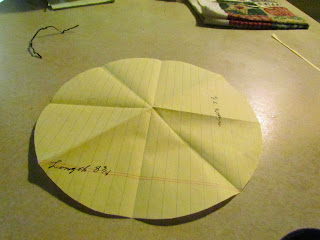To find the how much cloth you need, measure your table across the widest place (diameter.) I forgot to take a picture of Carrel measuring his table. I did not go over there, I can not get out in cold weather, because of my face. My table is 42 inches, I add a 9 inch drop, you have to double your drop. Diameter + 18 inches. I can make mine with material 60 inches wide. Carrel's table measured 48 inches add a 9 inch drop, you are adding 18 inches. You have to have a square to cut a round table cloth. I was so glad this material was 72 inches wide. The formula for this table is 48 + 18 = 66+1 inch for hem. What ever drop you want you have to double.
I have folded this material twice, once half 72 x67 I added 1 inch for hem, then you fold again, 36 x 33 and one half inches. Now you fold it into a triangle.
You measure from the tip of the triangle half of your diameter or radius 33 and one half inches. You can tie a piece of chalk on a heavy string, make sure it does not stretch, measure the length you need, which for me was 33 and one half inches. I did not have any string, so I used my measuring tape.
My counter is whiter than the fabric but not much. I hope you can see that I am measuring from the tip of the triangle. When I went to school and we were having the Geometry part of Algebra, some of the boys would say "Why are we having to learn this." I am so glad I had Mr. Malcolm La Fay in the 9th grade, he taught and I learned, if a child learns he never forgets. He helped me with my sewing in later years by telling us to pretend to have a black board in our minds. When I see a piece of material I can see how it would look made, on the blackboard in my mind. He wanted us to work our math in our mind instead of the piece of paper.
I really had a hard time cutting all these layers of fabric. I cut two at a time. I cut by the marking across the bottom of the fabric.
Turn up one fourth, then another one fourth more and you have your hem.
If your fabric is not wide enough you will have to buy two lengths.
If your fabric is 45 inches and you are making a 60 inch table cloth. You buy 2 length of 45 inch fabric 60 . Buy more if fabric is end is not straight. Cut one piece of 45 inch fabric 60 niches long. 45 +15+1 this is what you will need to add for a 60 inch square. You add 1on both sides of the 15 for 1/2 inch seams. Divide the 16 inch stripe into two equal pieces. divide by 2 = 8 inches. Sew one 8 inch strip to both sides of the 45 inch piece of cloth. 44+71/2 + 71/2 = 60, the 45 inch piece of fabric you used 1/2 inch. Follow the instructions above for making your table cloth. Do not forget to sig sag your seams and press.
I have taken a piece of yellow paper to show you how to fold your fabric. I cut this paper to make it square.
Fold the square of fabric that is the size of the table cloth you need width wise. 60 length wide 60 or whatever you need.
When you fold this time it should measure 1/2 of your table cloth at all sides.
Fold on the two diagonal ends of square.
Now you have a triangle. My cutting area was not big enough to cut this any other way. This is the best way to cut them.
Measure from the tip of the shorter side. The one that is half the size of your table cloth.
Then a circle.
You have cut off the corners of your square now you have a circle hem and you have finished.
I hope you have learned something from this blog page. If you have any questions please ask. I will do my best to answer them. Thank you for reading this blog and Happy sewing to you! Gerber Daisy (Juanita Sheffield)








































